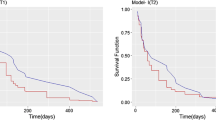Abstract
In this paper, we study a general additive frailty model along with some special cases and examples. The monotonicity of the population hazard is investigated in comparison to the baseline hazard rate. Examples are provided where the unconditional failure rate turns out to be increasing or bathtub shaped even when the baseline hazard is increasing. Association measure, for the additive case, of the correlated life times is studied with several examples.
Similar content being viewed by others
References
Aalen OO, Gjessing HK (2001) Understanding the shape of the hazard rate: a process point of view. Stat Sci 16:1–22
Agresti A, Caffo B, Ohman-Strickland P (2004) Examples in which misspecification of a random effects distribution reduces efficiency and possible remedies. Compuat Stat Data Anal 47:639–653
Barlow RE, Proschan F (1975) Statistical theory of reliability: probability models. Hole, Rinehart and Winston, New York
Barlow RE, Marshall AW, Proschan F (1963) Properties of probability distributions with monotone hazard rate. Ann Math Stat 34:375–389
Cha JH, Finkelstein (2014) Some notes on unobserved parameters (frailties) in reliability modeling. Reliab Eng Syst Saf 123:99–103
Clayton DG (1978) A model for association in bivariate life tables and its application in epidemiological studies of family tendancy in chronic disease incidence. Biometrika 65:141–151
Davis HT, Feldstein ML (1979) The generalized Pareto law as a model for progessively censored survival data. Biometrika 66(2):299–306
Duchateau L, Janssen P (2008) The frailty model. Springer, New York
Gupta RC, Gupta RD (2009) General frailty model and stochastic orderings. J Stat Plan Inference 139:3277–3287
Gupta RC, Gupta RD (2010) Random effect survival models and stochastic comparisons. J Appl Probab 47:426–440
Gupta RC, Kirmani SNUA (2006) Stochastic comparisons in frailty models. J Stat Plan Inference 136:3647–3658
Gupta RC, Warren R (2001) Determination of change points of non-monotonic failure rates. Commun Stat Theory Methods 30(8, 9):1903–1920
Gurland J, Sethuraman J (1995) How pooling failure data may reverse increasing failure rate. J Am Stat Assoc 90:1416–1423
Hanagal DD (2011) Modeling survival data using frailty models. Chapman and Hall, Boca Raton
Heckman JJ, Singer B (1984) The identifibility of the proportional hazard model. Rev Econ Stud 51:231–241
Hjorth J (1980) A reliability distribution withn increasing, decreasing, constant and bathtub-shaped failure rates. Technometrics 22:99–108
Hougaard P (1984) Lifetable methods for hetrogeneous populations: distributions describing the heterogeneity. Biometrika 71:75–83
Hougaard P (1991) Modeling hetereogeneity in survival data. J Appl Probab 28:695–701
Hougaard P (1995) Frailty models for survival data. Lifetime Data Anal 1:255–273
Hougaard P (2000) Analysis of multivariate survival data. Springer, New York
Kalbfleisch JD, Prentice RL (2002) The statistical analysis of failure time data. Wiley Interscience, New York
Kim J, Lee S (1998) Two sample goodness of fit test for additive risk models with censored observations. Biometrika 85:593–603
Klein JP, Moechberger ML, Li YH, Wang ST (1992) Estimating random effects in the Farmingham heart study. In: Klein JP, Goel P (eds) Survival analysis. State of the art. Kluwer Academic, Boston, pp 99–120
Lawless JF (2003) Statistical models and methods for life time data. Wiley Interscience, New York
Liang KY, Self SG, Bandeen-Roche KJ, Zeger S (1995) Some recent developments for regression analysis of multivariate failure time data. Lifetime Data Anal 1:403–416
Lin D, Oakes D, Ying Z (1998) Additive hazards regression with current status data. Biometrika 85:289–298
Lin DY, Ying Z (1994) Separametric analysis of the additive risk model. Biometrika 81:61–71
Lynch JD (1999) On conditions for mixtures of increasing failure rate distributions to have increasing failure rate. Prob Eng Inf Sci 13:33–36
Lynn NL, Singpurwalla ND (1997) Comment: “Burn in” makes us feel good. Stat Science 12:13–19
Martinussen T, Scheike TH (2002) Efficient estimation in additive hazards regression with current status data. Biometrika 89:649–658
Martinussen T, Scheike TH, Zucker DM (2011) The Aalen additive gamma frailty hazards model. Biometrika 98(4):831–843
Mukherjee SP, Roy D (1998) Bivariate distributions through Cox’s regression model. In: Mukherjee SP, Basu SK, Sinha BK (eds) Frontiers in probability and statistics. Norosa Publishing Co, New Delhi
Nair UN, Sankaran PG (2012) Some results on additive hazard model. Metrika 75:389–402
Oakes D (1989) Bivariate survival models induced by fralities. J Am Stat Assoc 84:487–493
Prekopa A (1973) On logarithmic concave measures and functions. Acta Sci Math 33:335–343
Shaked M (1977) A family of concepts of dependence for bivariate distributions. J Am Stat Assoc 72:642–650
Silva GL, Amaral Turkman MA (2004) Bayesian analysis of an additive survival model with frailty. Commun Stat Theory Methods 33:2517–2533
Tomazella VL, Louzada-Neto F, Silva GL (2006) Bayesian modeling of recurrent events data with an additive gamma frailty distribution and a homogeneous Poisson process. J Stat Theory Appl 5(4):417–429
Vaupel JW, Manton KG, Sttalard E (1979) The impact of heterogeneity in individual frailty on the dynamics of mortality. Demography 16(3):439–454
Wienke A (2010) Frailty models In survival analysis. Chapman & Hall/CRC, Boca Raton
Yin G, Ibrahim JG (2005) A class of Bayesian shared gamma frailty models with multivariate failure time data. Biometrics 61:208–216
Acknowledgments
The author is thankful to the referee for some useful suggestions which enhanced the presentation.
Author information
Authors and Affiliations
Corresponding author
Rights and permissions
About this article
Cite this article
Gupta, R.C. Properties of additive frailty model in survival analysis. Metrika 79, 1–17 (2016). https://doi.org/10.1007/s00184-015-0540-1
Received:
Published:
Issue Date:
DOI: https://doi.org/10.1007/s00184-015-0540-1




